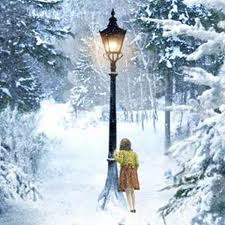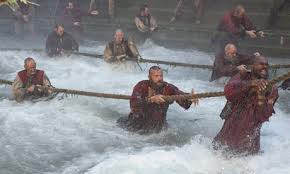The English countryside. Stark, spacious. At the beginning of The Lion, The Witch and the Wardrobe Mrs. Pevensie puts her four children on a train. The time period is the second World War and the nightly air raids in London lead the children's mother to the decision that they will go and live with their relatives in the countryside. So they go join their eccentric professor uncle. The setting is stark. The countryside sounds beautiful, the castle large and looming, dark and overwhelming. The children are often bored and find themselves spending time in useless pursuits. The brief scene in London could certainly foreshadow the future spiritual warfare battles the Pevensie children will face against the White Witch and the evil forces of Narnia. Yet the house in the countryside itself provides a different type of spiritual battle. The children face the forces of boredom and laziness, the sources of many a temptation. At their wit's end, fights between family members are frequent.
Suddenly an ordinary wardrobe full of coats is transformed into something magnificent. We've been established in the Pevensies world, now we move to a new location. The spiritual landscape of Narnia is immediately established as a different type of setting. The lantern Lucy sees when she stumbles through the back of the wardrobe is a symbol of the light found in Narnia. The landscape itself is beautiful, covered with luscious forests and deep lakes. The sense of color is a quick contrast to the grays and dark greens of the countryside house. Narnia is a magical place. We see the setting and we are immediately transfixed. Though many battles will take place in Narnia, we also see a clear source of light. The landscape itself is involved in a spiritual battle, because of the White Witches presence Narnia and the lands surrounding it are in a long-lasting winter season. The ice on the trees, the snowy mountaincaps are all intensely beautiful. Here we see that evil can appear beautiful on the surface.
One of my favorite recent movies is Les Miserables. A few months ago I discussed developing a more believable villain using Javert in the 1998 version. The setting itself in many places is part of the spiritual thread that holds the movie together. This time I am focusing specifically on the 2012 version. The movie begins with a camera focusing in on a large ship. The colors are stark and the sea is raging. Within thirty seconds, the viewer understands that this is a place of great spiritual and emotional darkness. Javert stands against the landscape, nightstick in hand, like a sentinel guarding the prisoners as they lift the ship and drag it to shore. A mere few minutes later, main character ValJean is dismissed. His parole has begun, not to be confused with his freedom. As ValJean begins the long walk to visit the police department for his papers, the camera shows a more wide-angle view. The world is more vast, but as he ascends gray rocks, his world is still shown through a dark lens. He has not yet achieved freedom.
The first glimpse of beauty we see in the setting of the movie is a chapel ValJean enters after his encounter with a local priest. ValJean returns to his default setting of stealing and takes some silver, but is offered tremendous mercy by the priest who asks why he didn't take the candlesticks as well. During their exchange, he tells ValJean, he must become a changed man. The first beautiful place we see is the chapel he sits in, repenting of his former life and vowing to become a new man. There are many scenes here that take place in a chapel and the Cross on the wall becomes a beautiful symbol of meaning. We see the stained-windows of the church here and watch in glorious triumph as Jean ValJean exits the church, ripping up his parole papers which demonstrate his "old man." There is a beauty as we watch these papers falling in the wind, a place that was ordinary becomes a setting of freedom.
My first work-in-progress takes place in a compound-like setting in the countryside in Utah This community may not have a physical border provided by fences, but there is a natural border provided by a dense forest on the edge of the town. Those who cross these borders are punished and further face the threat of "eternal judgement" from the elders. The houses are close together, it isn't hard for your neighbor to know your business or to "tattle" on you to the church board. The small luxury of beauty is provided by a garden in my main character Rachel's yard. The houses look very similar in style on the outside and there is little variation in decor on the inside. Isolated and depressed, the setting reflects Rachel's spiritual state. She lives by the rules created by the Prophet missing the freedom of life in Christ.
Whether its the peaceful quiet of the nunnery in Paris ValJean and his daughter escape into or the stark moors of England in Jane Eyre setting is linked with the spiritual thread of story. Paying heed to the type of spiritual atmosphere you want to form will help you in creating your setting, whether a real or imagined place.
Do you have a favorite book in which the setting and the spiritual arc play off each other? How about in your own novel?
Julia enjoys writing women's fiction whenever she can find a chair free of smushed peanut butter sandwiches and lego blocks. She is a wife and homeschooling mama of two littles. She also enjoys reading and reviewing books for Library Journal, The Title Trakk, and Christian Library Journal.






















6 comments:
Oh Julia, this was an incredible post. Your examples of setting and the spiritual were spot on! I love Narnia and the way you showed the spiritual aspect of it was brilliant!
I think of North and South and the contrast between the two. In the movie the South is lush and green, while the North is stark and grey. The North speaks of hard times and trouble, while the South speaks of a life of ease and tranquility. Almost a heaven/hell picture.
Thanks, Julia! I loved this!
Loved your spin on this setting series! Awesome!
SHERRINDA,
Great example, one I wouldn't have thought of but perfect. With North & South I also think of overcoming prejudices. Interesting parallel.
AMY,
Thanks for chiming in!
Julia, great examples to show the spiritual side of our story. I admit, I need to work on this more. I'm getting better at using it to portray emotions, now I'll work on the spiritual aspect. :)
Great post today. :)
Julia, I love those examples. My current wip is set in the cotton fields of Texas. I use the imagery of the cotton and farming throughout the book for spiritual imagery. The whole theme is portrayed in the cotton boll...only until the plant is dead is the cotton ready for harvest-pure and white. Pretty significant in my character's personal journey. :)
JEANNE,
I, too, need to work on this more. I'll admit I always write on things I need to work on (which is most everything). :) Thanks for coming by!
ANGIE,
Ooohhh, I love that. I think you have some great imagery in this story.
Post a Comment